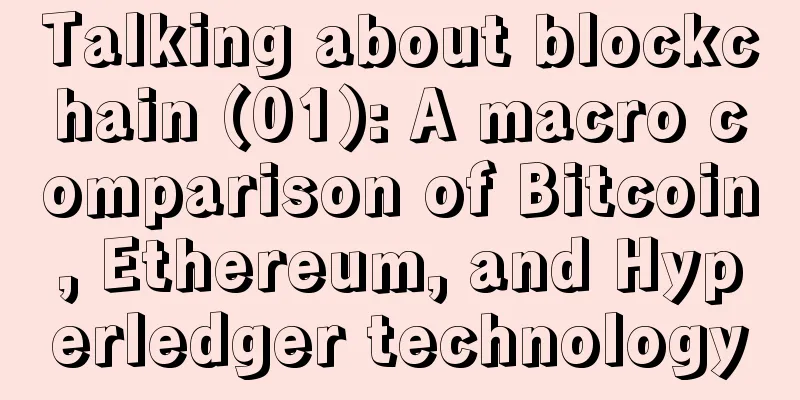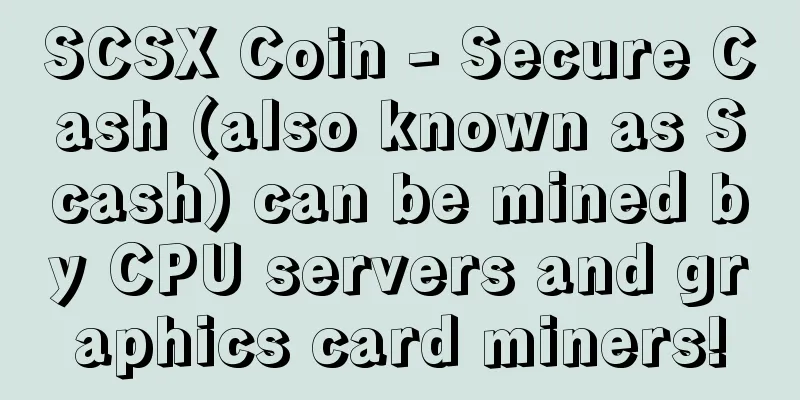Talking about blockchain (01): A macro comparison of Bitcoin, Ethereum, and Hyperledger technology

|
Today is the opening of the "Talking about Blockchain" column. I have been following Babbitt for some years, but today is my first day as a columnist. Let me introduce myself first. Tan Guopeng: Founder of Bitbill (bitbill.com), the earliest explorer of Bitcoin payment. He has been engaged in the research and exploration of Bitcoin, Ethereum, Hyperledger and other blockchains, and is currently the head of blockchain research and development at Sany Group. Talking about blockchain means talking about blockchain for Tan Guopeng. This column is planned to be written from issue 01 to issue 108, mainly focusing on technology sharing, and will also include blockchain business models, personal thoughts and other content. Serious reminder: Any content and opinions in this column represent personal opinions only. Now let's get to the point. Students who are familiar with Bitcoin technology often feel confused when learning Ethereum and Hyperledger (both refer to Hyperledger Fabric). Let's sort it out as follows: 1. Biggest confusion: What is worldstate? There is no concept of accounts in Bitcoin, and all balances are calculated through 2. Where is the worldstate stored? This question will make Bitcoin developers more confused, because for Bitcoin, each node maintains a complete blockchain, and no other data needs to be stored. Where is the worldstate information (that is, account-related information) stored for Ethereum and hyperledger? Is it in the blockchain or somewhere else? Is it stored on the chain or off the chain? The answer is off the chain. In fact, each block of Ethereum and hyperledger will only contain a hash of the entire data set of the current corresponding worldstate, called worldstate-hash. The complete worldstate data of Ethereum is stored in 3. Different block speeds Everyone should be clear about this. Bitcoin generates a block every 10 minutes on average (for beginners, let me explain that it is an average, not a fixed time. The processing logic is that as long as the miner calculates the answer, the block will be generated immediately, which may be as fast as a few seconds or as slow as a few hours). Ethereum generates a block every 10 seconds on average, and Hyperledger generates a block for each transaction by default. It also supports 4. Different consensus mechanismsBitcoin is the originator of PoW, Ethereum currently also uses PoW, and Hyperledger uses the IBM version of PBFT. PoW requires the design of tokens (Bitcoin and Ethereum, used to reward miners and prevent attacks), but PBFT does not necessarily need to do so, so Hyperledger currently does not have a built-in token. 5. Do Ethereum and Hyperledger support SPV?SPV has played an indispensable role in the success of Bitcoin. Satoshi Nakamoto's genius is reflected in many aspects, and SPV is one of them. If there is no SPV, I believe that few people will play Bitcoin now. Imagine downloading a wallet and waiting for several days to synchronize before using it. What kind of experience is that! I haven't studied whether Ethereum currently supports SPV. But hyperledger currently does not support it (currently talking about fabric version 0.6.1), and not supporting SPV will be a disaster! This is the first post today, so I’ll write this much for now. I’ll continue another day! |
<<: Well-known market research organization: Blockchain + insurtech creates a $235 billion market
>>: Overstock's blockchain stock offering was a success, raising $10.9 million
Recommend
What does a mole on a man's testicle mean?
Everyone has moles on their body to a greater or ...
The address of the Ronin attacker who stole $620 million was included in the sanctions list by the US Treasury Department. North Korean hacker group may be the mastermind behind it
A sanctions list released by the U.S. Treasury De...
Google data shows that searches for "buy Bitcoin" are rising
Perhaps because the US presidential election is b...
Black mole fortune telling diagram
Black mole fortune telling diagram Illustrated gu...
Wang Yongli, former vice president of Bank of China: How do you view the US OCC's relaxation of stablecoin usage?
Original title: "Wang Yongli | How to view t...
Complete analysis of the face and mole of the Palace of Illness
As one of the traditional physiognomy techniques, ...
NBA Mavericks owner Mark Cuban tells 7.1 million fans: I'm already following Bitcoin, you should too
Bitcoin has clearly gained a lot of mainstream at...
Blockchain competition is emerging: two technical routes have become the mainstream of development
Recently, a blockchain whirlwind has swept the fi...
What kind of face is the most prosperous?
Have you missed your marriage? 1. People with goo...
Palmistry characteristics of good luck in life
Almost everyone in life hopes that they can have ...
Is it good for people to have wrinkles on their foreheads?
In physiognomy, if there is a horizontal line on ...
Is there a relationship between talking too much and losing money and moles at the corners of the mouth?
Is there a relationship between talking too much ...
Cheekbones reveal your personality and destiny
Cheekbones reveal your personality and destiny In...
How many of the facial features that indicate a prosperous husband do you have?
If a man can marry a woman who brings good luck t...
What kind of woman's face will bring her a lifetime of blessings?
Simply put, physiognomy is the study of fortune b...









